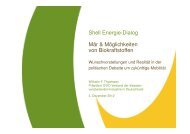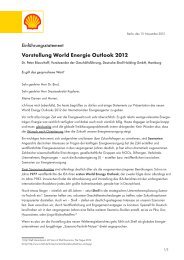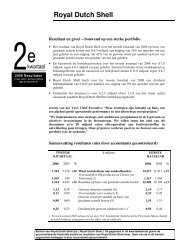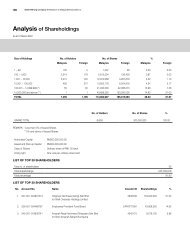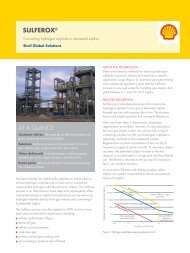62414 sustain 40pp (Mag)
62414 sustain 40pp (Mag)
62414 sustain 40pp (Mag)
You also want an ePaper? Increase the reach of your titles
YUMPU automatically turns print PDFs into web optimized ePapers that Google loves.
CO2 capture technology<br />
The world is demanding much more energy<br />
for development (which currently means more<br />
fossil fuels) and a solution to climate change.<br />
It cannot have both unless safe and costeffective<br />
ways are found to capture and store<br />
CO2 from coal, oil and natural gas.<br />
There are many technical options for capturing<br />
CO2. Once it is captured, CO2 can then be<br />
stored underground (in aquifers or in some oil<br />
and gas fields). It can also be used in industrial<br />
processes. However, capturing and storing CO2<br />
is energy intensive and expensive. At a mediumsized<br />
coal-fired power plant, for example,<br />
capture and storage would lower the plant’s<br />
overall energy efficiency by about 10% and add<br />
several hundred million dollars to investment<br />
costs. Storage will also require acceptance by<br />
planning authorities and by local communities.<br />
We are involved in large-scale demonstration<br />
projects in this area. One of these is ZeroGen,<br />
a low CO2 coal-fired power project being<br />
considered in Australia (see box). Another, in<br />
Norway, is the largest offshore project to date to<br />
store CO2 and use it to enhance oil recovery. If<br />
it were to go ahead, the Halten project, which<br />
we are working on together with the Norwegian<br />
Government and Statoil, would solve a power<br />
105<br />
100<br />
95<br />
90<br />
85<br />
ENERGY INTENSITY – IN OUR CHEMICAL PLANTS<br />
Chemicals Energy Index*<br />
97 98 99 00 01 02 03 04 05 06 07<br />
*2000 is baseline Actual Targets<br />
shortage in central Norway and reduce CO2<br />
emissions by up to 2.5 million tonnes a year.<br />
Both projects are at the feasibility stage.<br />
We are also supplying waste CO2 from our<br />
Pernis refinery to greenhouses in the<br />
Netherlands and exploring CO2 management<br />
opportunities in the Middle East with<br />
Mitsubishi Heavy Industries.<br />
Government policy will play a decisive role in<br />
determining the future of CO2 capture and<br />
storage. The significant additional investment<br />
involved means it will not be rolled out on a<br />
large scale without government action. At the<br />
moment, emission reductions achieved through<br />
capture and storage do not qualify for emission<br />
credits. Our appeal is for more effective project<br />
permitting and measures to reduce costs, for<br />
example through the European Technology<br />
Platform for Zero Emission Fossil Fuel Power<br />
Plants. These include granting carbon credits<br />
for captured CO2, and setting emission targets<br />
beyond 2012 to create a stable long-term<br />
investment framework.<br />
1.2<br />
0.9<br />
0.6<br />
0.3<br />
ENERGY INTENSITY – IN EXPLORATION & PRODUCTION<br />
Gigajoule/tonne production<br />
97 98 99 00 01 02 03 04 05 06 07<br />
Actual<br />
Target<br />
Winner of the Shell Eco-marathon 2006. A biofuel-powered<br />
prototype which won with an energy consumption equivalent<br />
to 2,885 km/l of petrol.<br />
MONOTOWERS: LEARNING FROM OUR<br />
ALTERNATIVE ENERGY BUSINESS<br />
In 2006, we began operating the world’s first<br />
offshore natural gas production platforms<br />
powered by wind and solar electricity. This<br />
lightweight, low-cost and zero-emission<br />
platform – called a monotower because it<br />
stands on a single leg – is based on the design<br />
used for offshore wind turbines. Monotowers<br />
make it possible to tap small natural gas fields<br />
in the North Sea that would be uneconomic<br />
with traditional equipment. Developing these<br />
fields helps increase and diversify energy<br />
supplies by extending the production life of<br />
mature regions like the North Sea.<br />
We began operating two monotowers in<br />
2006. Each platform uses just 1.2 kilowatts<br />
of power per day. That is less than it takes<br />
to boil a kettle and much less than the<br />
30 kilowatts needed to operate a traditional<br />
unmanned platform or the 40 megawatts<br />
that a full-size, manned facility requires.<br />
THE SHELL SUSTAINABILITY REPORT 2006 13


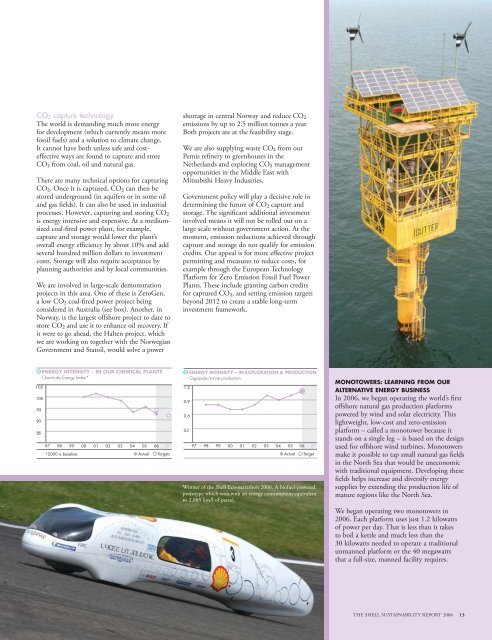
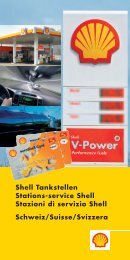
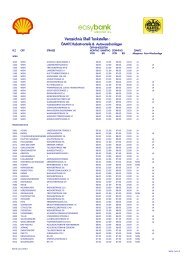
![Download Shell AutoGas Stationen [Stand: Januar 2013] (PDF](https://img.yumpu.com/9982753/1/190x245/download-shell-autogas-stationen-stand-januar-2013-pdf.jpg?quality=85)
